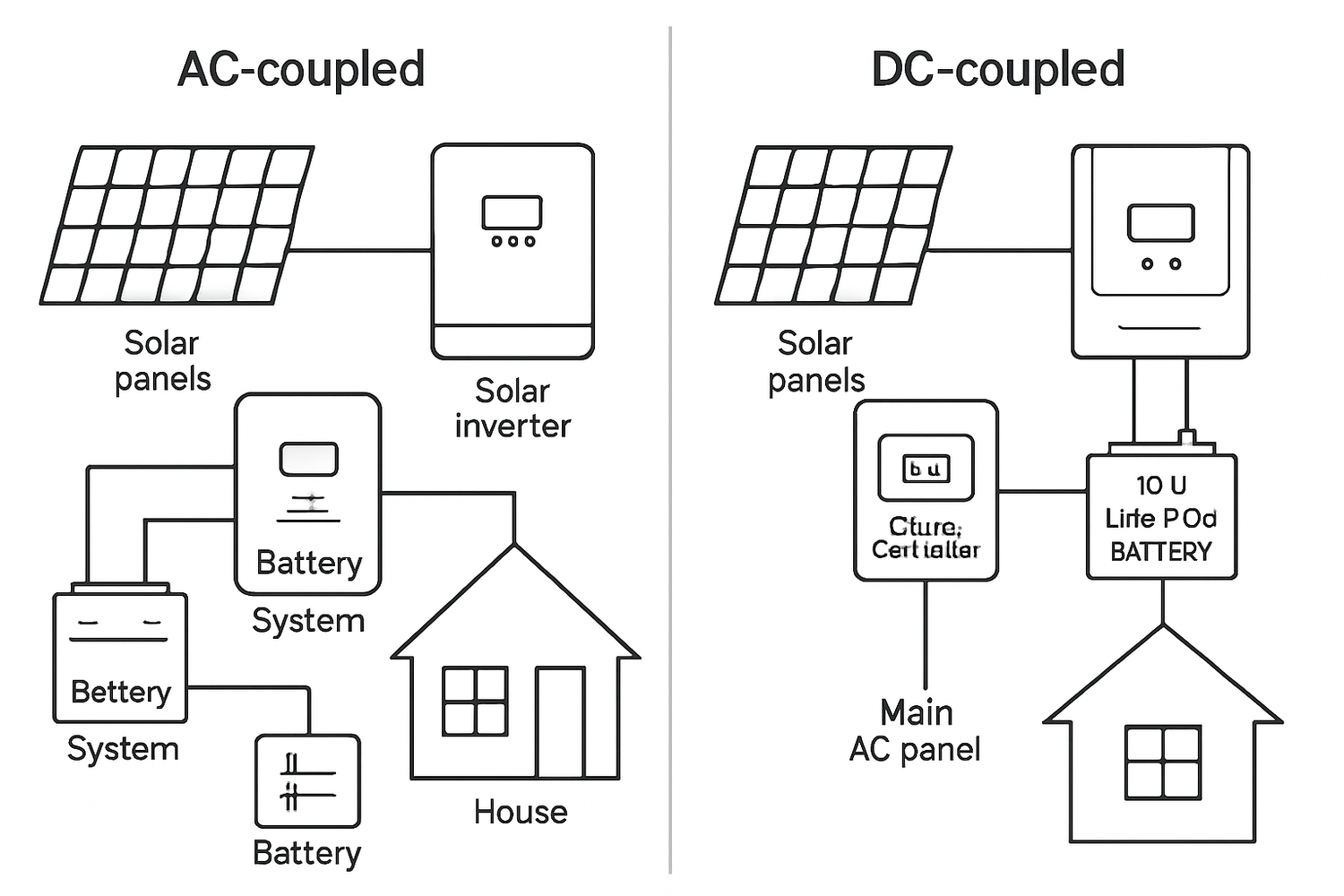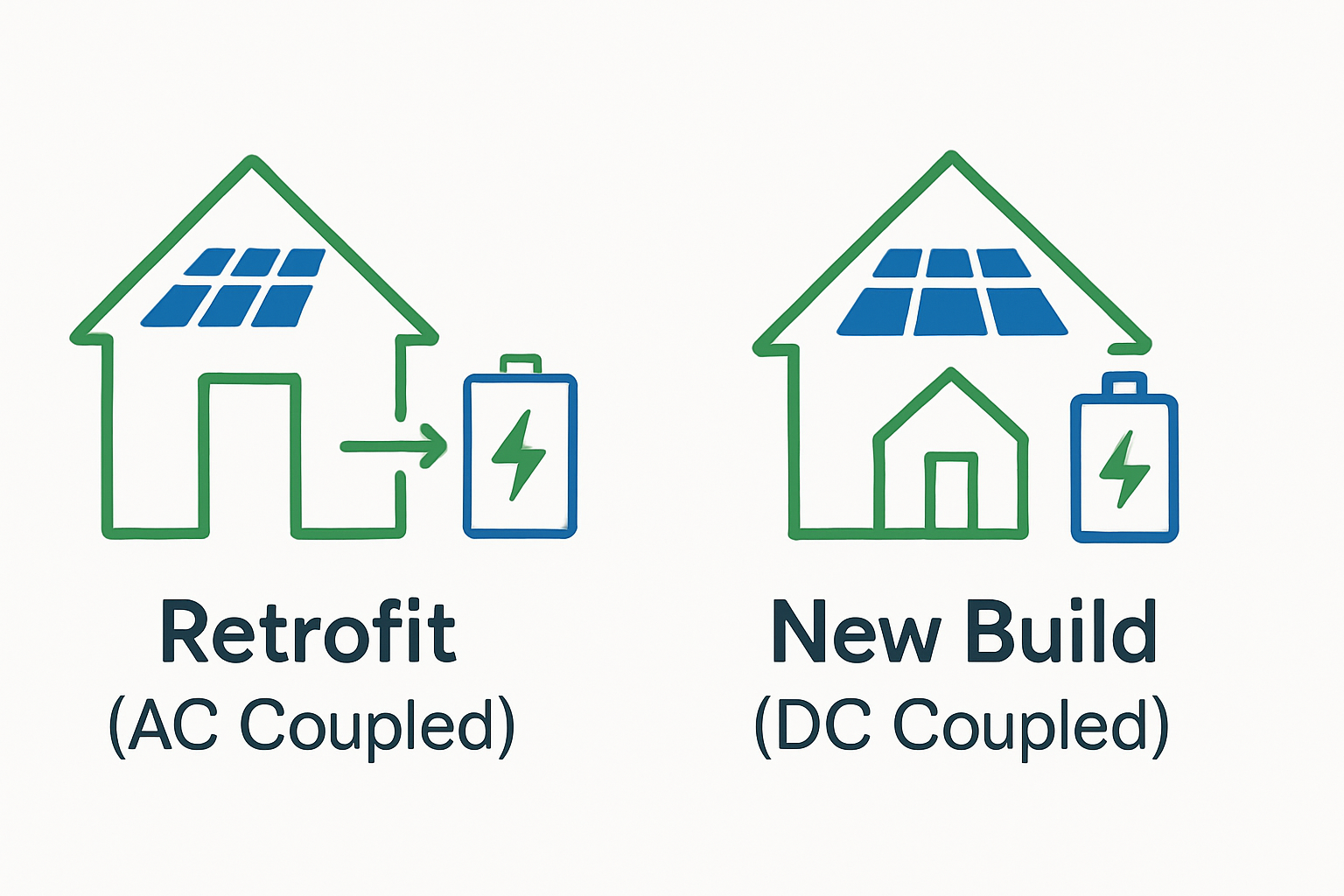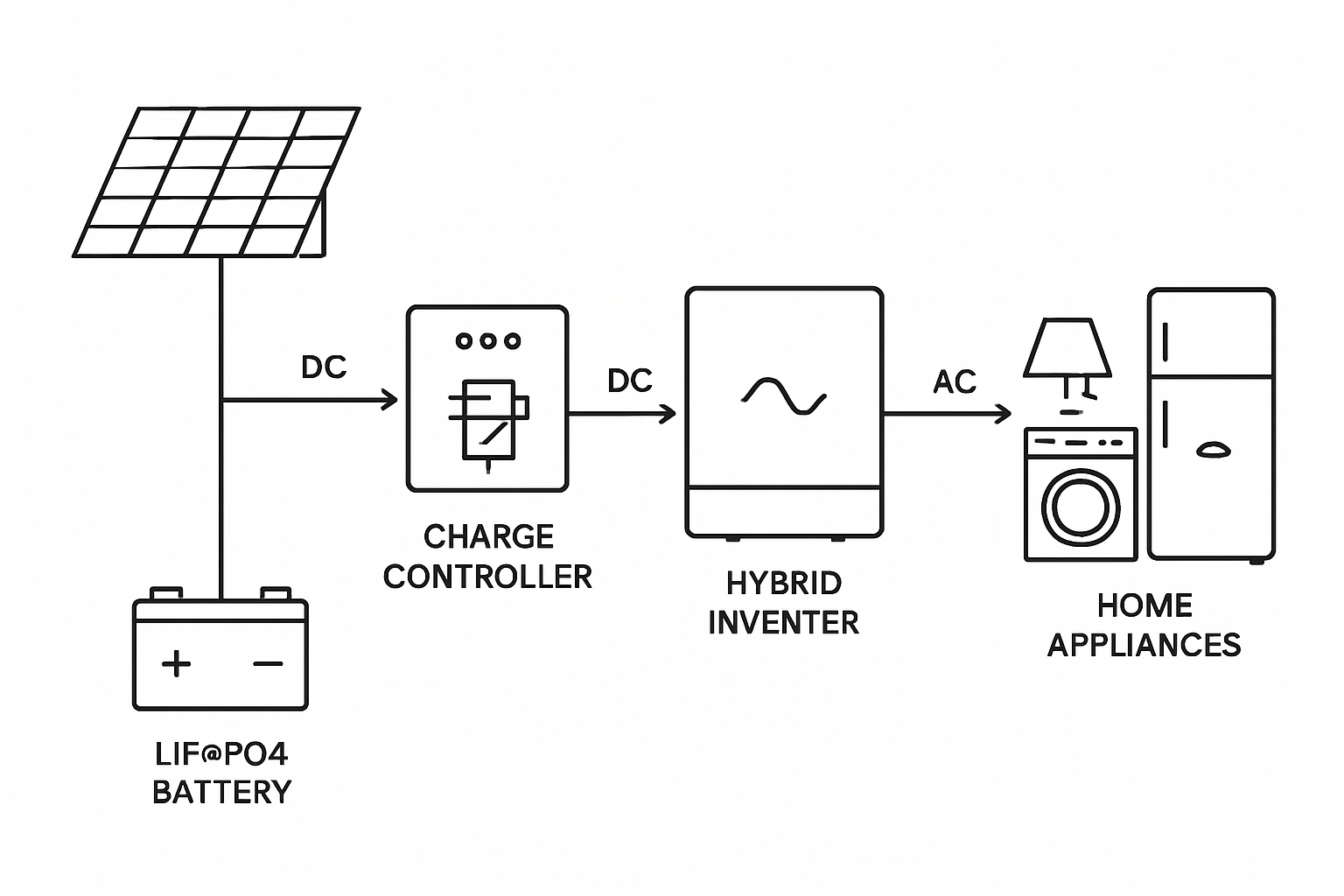The 12V LiFePO4 battery is a cornerstone of modern energy storage, valued for its high performance, safety, and longevity. However, unlocking its full potential depends on the architecture of the surrounding system. A critical engineering decision is the choice between AC-coupled and DC-coupled configurations. This choice influences everything from round-trip efficiency to installation complexity and overall cost. This analysis provides a technical comparison to help you design a superior energy storage solution.
Understanding Core Architectures: AC vs. DC Coupling
The way a battery integrates with a solar array defines whether the system is AC or DC coupled. Each approach has a distinct flow of energy and component arrangement, making them suitable for different applications.
The DC-Coupled System
In a DC-coupled architecture, the direct current (DC) power generated by solar panels is fed through a charge controller directly to the 12V LiFePO4 battery bank. Since solar panels and batteries both operate on DC, this is the most direct way to charge. A single hybrid inverter then converts the DC power from either the panels or the battery into alternating current (AC) to power household appliances. This streamlined design is highly efficient and is a common choice for new, off-grid solar installations.
The AC-Coupled System
An AC-coupled system functions more like two independent systems working in tandem. The solar panels are connected to their own grid-tie inverter, which immediately converts DC power to AC power for use in the home. To charge the battery, this AC power is then directed to a separate battery inverter (or an inverter/charger), which converts it back to DC for storage. When the stored energy is needed, the battery inverter converts it back to AC. This configuration is exceptionally well-suited for retrofitting a battery system onto an existing grid-tied solar array.
Key Architectural Differences
The fundamental distinction lies in the number and function of the inverters and the path the energy takes. A DC-coupled system minimizes power conversions for storage, while an AC-coupled system provides greater modularity.
| Feature | DC-Coupled System | AC-Coupled System |
|---|---|---|
| Primary Components | Solar Panels, Charge Controller, Hybrid Inverter, Battery | Solar Panels, Solar Inverter, Battery Inverter, Battery |
| Energy Flow for Storage | Solar (DC) -> Charge Controller -> Battery (DC) | Solar (DC) -> Solar Inverter (AC) -> Battery Inverter (DC) -> Battery (DC) |
| Best Use Case | New off-grid or hybrid installations | Retrofitting existing grid-tied solar systems |
A Deep Dive into System Efficiency and Performance
System efficiency is not just a number on a spec sheet; it translates directly to usable energy and long-term value. The primary metric for comparison is round-trip efficiency, which measures the energy out of a battery relative to the energy put in.
The Nuances of Round-Trip Efficiency
DC-coupled systems generally exhibit higher round-trip efficiency because there are fewer power conversions. When charging directly from solar, the energy only undergoes one conversion from DC to AC when it's finally used by appliances. This results in typical round-trip efficiencies of 95% or higher. In contrast, AC-coupled systems involve multiple conversions (DC-AC from the solar inverter, then AC-DC into the battery), which introduces more energy loss at each step. Their efficiency is typically between 90–94%. While a few percentage points may seem minor, these losses compound over the battery's lifetime. A comprehensive analysis of solar storage performance demonstrates that minimizing conversion losses is a key factor in maximizing the usable energy from your system. According to the International Renewable Energy Agency (IRENA), as solar and storage become more integrated, optimizing these systems is crucial for a cost-effective energy transition.
Performance Under Different Conditions
DC-coupled systems excel at capturing solar energy that would otherwise be lost to 'inverter clipping'. This occurs when solar panels produce more DC power than the inverter can handle. In a DC-coupled setup, this excess power can be diverted directly to charge the 12V LiFePO4 battery, effectively recovering clipped energy. This can translate to a significant increase in annual energy capture, especially in systems where the solar array is oversized relative to the inverter. AC-coupled systems offer operational flexibility. Because the solar array and the battery are on separate inverters, a failure in one does not necessarily disable the other. This modularity can be an advantage in grid-tied systems where reliability is paramount.
Installation, Scalability, and Cost Considerations
The practical aspects of installation and future expansion are just as important as technical performance. Here, the differences between AC and DC coupling become even more apparent.
Installation Complexity and Retrofitting
For retrofitting a battery onto an existing solar installation, AC coupling is almost always the simpler and more cost-effective method. It allows the battery system to be added with minimal disruption to the existing solar hardware. DC-coupled systems are more integrated, which can make the initial installation for a new system more streamlined, but retrofitting one requires replacing the existing solar inverter with a compatible hybrid inverter, adding complexity and cost.
Scalability and Future-Proofing
AC-coupled systems are generally easier to scale. If you decide to increase your storage capacity, you can add another battery and battery inverter without reconfiguring your solar array. This modular approach provides greater flexibility for future upgrades. Scaling a DC-coupled system may require ensuring your initial hybrid inverter and charge controller are sized to handle future expansion, which involves more upfront planning.
A Realistic Look at Costs
For a brand-new installation, a DC-coupled system can have lower initial capital costs because it requires fewer primary components (one hybrid inverter vs. two separate inverters). Some data suggests DC-coupled systems can achieve 10-20% lower capital costs in new builds. However, for retrofits, AC coupling is more economical as it preserves the investment in the original solar inverter. Installation costs can also be lower for AC-coupled retrofits due to the reduced complexity.
Disclaimer: This article provides technical information and is not investment advice. Consult with a qualified professional for financial decisions.
Making the Right Choice for Your Application
The optimal choice is not universal; it depends entirely on the specific project requirements. The U.S. Energy Information Administration (EIA) notes a significant rise in residential solar and storage systems, making these design choices increasingly relevant for homeowners aiming for energy independence.
New Off-Grid Systems
For new off-grid installations where maximizing every watt-hour from solar is critical, a DC-coupled system is the superior choice. Its higher efficiency in converting and storing solar energy makes it ideal for achieving self-sufficiency.
Retrofitting Existing Solar Installations
If you already have a grid-tied solar panel system and wish to add energy storage, an AC-coupled system is the logical path. Its ease of installation and compatibility with existing hardware make it the preferred option for upgrades.
Hybrid and Grid-Tied Systems with Backup
For new grid-tied systems that include battery backup from day one, the decision is more nuanced. If your primary goal is the absolute highest efficiency for solar-to-battery charging, DC coupling is better. If you prioritize flexibility, easier future expansion, and modularity, AC coupling may be more suitable.
Final Engineering Considerations
The decision between AC and DC coupling is a foundational element of designing a high-performance energy storage system around a 12V LiFePO4 battery. DC-coupled systems offer a direct, highly efficient path for new installations, particularly off-grid. AC-coupled systems provide unmatched flexibility and ease for retrofitting existing solar arrays. By carefully evaluating your project's specific goals—whether it's a new build or an upgrade, off-grid or grid-tied—you can select the architecture that will maximize the value and reliability of your energy storage investment, paving the way toward greater energy independence. As IRENA reports highlight, effective integration of storage is a key enabler for the global transition to renewable energy.
Frequently Asked Questions
Can I use a 12V LiFePO4 battery in both AC and DC coupled systems?
Yes, the 12V LiFePO4 battery itself is compatible with both architectures. The choice of coupling determines the surrounding components like inverters and charge controllers, not the battery chemistry.
Which system is better for a home battery storage system?
It depends. For a new solar and battery installation, a DC-coupled system is often more efficient. For adding a battery to an existing solar panel system, an AC-coupled system is typically easier and more cost-effective to install.
Does coupling type affect the lifespan of my lithium iron phosphate battery?
The coupling type itself does not directly impact the battery's chemical lifespan. However, a correctly designed system with a compatible Battery Management System (BMS) and proper inverter settings is crucial for battery health in either configuration. Poor system integration can lead to suboptimal charging and discharging cycles, which can affect longevity.
What is 'inverter clipping' and how does it relate to DC coupling?
Inverter clipping occurs when solar panels produce more DC power than the inverter is rated to convert to AC. In a standard grid-tied system, this excess energy is lost. In a DC-coupled system, this surplus DC power can be efficiently rerouted to charge the battery, capturing energy that would otherwise be wasted.





Leave a comment
All comments are moderated before being published.
This site is protected by hCaptcha and the hCaptcha Privacy Policy and Terms of Service apply.